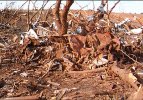This is some of the most violent contextual damage I’ve ever seen, hands down.
Back in the 1990s, had someone asked me to visualise an “F5” tornado, Bridge Creek would have been the very first to come to mind, along with Jarrell. Bridge Creek is still the archetypal F5 in many ways: a massive, mile-wide wedge that produced the highest winds measured by mobile Doppler radar
and the contextual damage to match its high-end intensity. It met all the F5 criteria: extreme ground and pavement scouring, well-anchored homes obliterated, debris granulated and carried far from empty homesites, trees and shrubs stubbed, debarked, and uprooted, vehicles and railcars either pulverised or hurled/rolled up to a mile away or both...and many (E)F5 tornadoes usually only meet
some of the criteria, not all of them, and most certainly do not peak in the vicinity of DOWs. So in this respect Bridge Creek is still rather unique. Jarrell comes very close to Bridge Creek in meeting all the criteria, except that it lacked confirmation-by-DOW. But both events are unquestionably, deservingly considered F5s, and not “marginal” or “low-end” ones, regardless of what surveys may indicate. Both are among the best documented of all the legendary, high-end (E)F5s on record, with high-resolution photography and numerous accounts to prove their worth. Like El Reno (2011), Bridge Creek was also an unusually long-tracked (E)F5 for the Great Plains, and both are absolutely comparable to each in other in terms of intensity at ground level. Jarrell, Bridge Creek, and El Reno (2011) are among the most intense tornadoes on record, period.

























